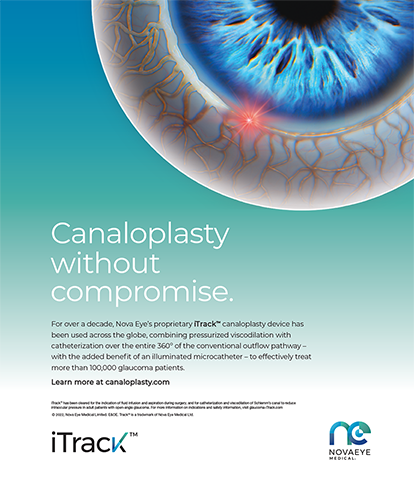The transition from intracapsular to extracapsular surgery in the 1970s lowered the rate of postoperative endophthalmitis significantly.1 A study by Kattan et al2 examined cataract surgeries performed at the Bascom Palmer Eye Institute in Miami between 1984 and 1989. The results from this study showed that the rates of postoperative endophthalmitis for intracapsular and extracapsular surgery were 0.093% and 0.072%, respectively.
SCLERAL TUNNEL PHACOEMULSIFICATIONThe transition from extracapsular surgery to scleral tunnel phacoemulsification has not shown a clear trend as regards endophthalmitis. Many studies indicate that the endophthalmitis rates are similar between the two techniques.1 Some ophthalmologists even suggest that phacoemulsification may be associated with a higher risk of infection than extracapsular surgery. A study by Wong et al3 looked at the cataract surgeries performed between 1996 and 2001 at the Singapore National Eye Center. A total of 44,803 surgeries were performed, including 25,476 phacoemulsification and 19,327 extracapsular surgeries. The study showed that there was a relative risk of 1.9 for acute postoperative endophthalmitis in the phacoemulsification group compared with the extracapsular group.3
CLEAR CORNEAl PHACOEMULSIFICATIONOf late, cataract surgeons have been transitioning from scleral tunnel to clear corneal phacoemulsification. The recent literature has raised the possibility that clear corneal phacoemulsification may be associated with a higher rate of postoperative endophthalmitis when compared with scleral tunnel phacoemulsification.
A case control study performed by Cooper et al4 examined 38 patients with culture-positive endophthalmitis. Of these patients, 17 had undergone clear corneal phacoemulsification, and 21 had undergone scleral tunnel phacoemulsification. This study group was compared with a control group of 371 randomly chosen patients who underwent uncomplicated cataract surgeries, 76 of which were clear corneal. The investigators found that a clear corneal incision was associated with a relative risk of 3.36 with a 95% confidence interval of 1.67 to 6.78. Although a well-conducted study, its one major caveat is that the controls were not matched to the study group in terms of age, gender, or ocular and medical comorbidities. The unmatched study and control groups, when compared, could have masked many confounders that could have predisposed a group toward a higher rate of infection. In addition, only 20% of the patients in the control group had clear corneal surgery versus 45% in the study group, a fact that certainly could have affected the statistics of the study. On the other hand, a retrospective chart review performed by Colleaux et al5 studied 13,886 cataract surgeries performed by nine surgeons in Saskatoon, Canada, between 1994 and 1998. According to the investigators, the incidence of endophthalmitis was 0.129% with clear corneal surgery and 0.050% with scleral tunnel surgery. Although the finding was not statistically significant, a clear difference appeared in the endophthalmitis rates of the two groups. The rate for the scleral tunnel group is similar to that quoted by other studies, whereas the rate for the clear corneal group is more than double that of the scleral tunnel surgery group. Perhaps with a larger study, a statistically significant difference could be shown for this rare complication.
BOTTOM LINEThe increasing preference for clear corneal phacoemulsification forces ophthalmologists to take a hard look at its risks and benefits compared with the more traditional surgical techniques. It is exceedingly difficult to perform a randomized prospective study to analyze the predisposing factors for postoperative endophthalmitis because (1) postoperative endophthalmitis is such a rare event, (2) surgeons have preferred techniques of cataract extraction, and (3) it is difficult to randomize patients in a study. The trend of an increased incidence of culture-positive infection hinted at by the aforementioned studies could be secondary to multiple confounders, including poor wound closure, a temporal versus superior position of the wound, an increased awareness of the complication, and an improved culturing ability. While waiting for more definitive studies, surgeons must take care to plan well preoperatively, construct wounds meticulously, and be vigilant postoperatively to prevent and treat such a complication appropriately for the best visual outcome.
ReviewerWei Jiang, MD, may be reached at (310) 825-5000; wjiang70@yahoo.com.
Panel Members
Y. Ralph Chu, MD, is Medical Director, Chu Vision Institute in Edina, Minnesota. Dr. Chu may be reached at (952) 835-1235; yrchu@chuvision.com.
Nina Goyal, MD, is a resident in ophthalmology at the Rush University Medical Center in Chicago. She may be reached at (312) 942-5315; ninagoyal@yahoo.com.
Baseer Khan, MD, is a senior resident in ophthalmology in the Department of Ophthalmology at the University of Toronto. He may be reached at (415) 258-8211; bob.khan@utoronto.ca.
Gregory J. McCormick, MD, is a resident in ophthalmology at the University of Rochester Eye Institute in New York. He may be reached at (585) 256-2569; mccormick_greg@hotmail.com.
Jay S. Pepose, MD, PhD, is Professor of Clinical Ophthalmology at Washington University, St. Louis. He may be reached at (636) 728-0111; jpepose@peposevision.com.
Paul Sanghera, MD, is a resident in ophthalmology in the Department of Ophthalmology and Vision Sciences at the University of Toronto. He may be reached at (416) 666-7115; sanghera@rogers.com.
Tracy Swartz, OD, MS, may be reached at (615) 321-8881; drswartz@wangvisioninstitute.com.
Ming Wang, MD, PhD, may be reached at (615) 321-8881; drwang@wangvisioninstitute.com.


